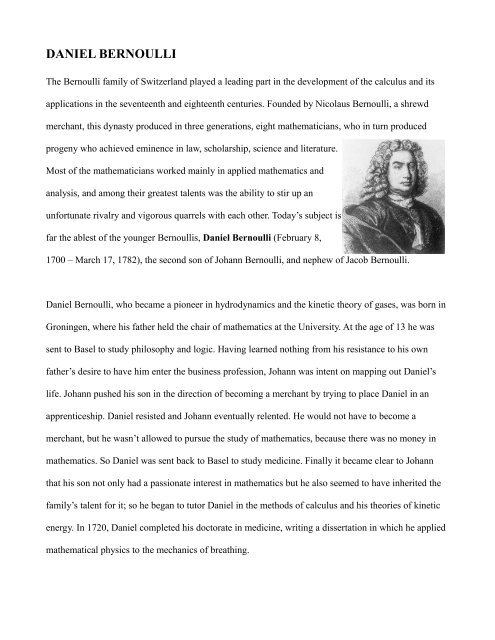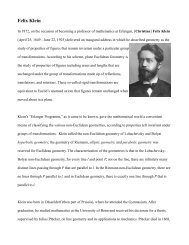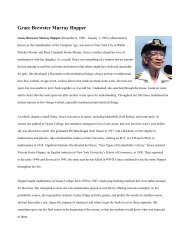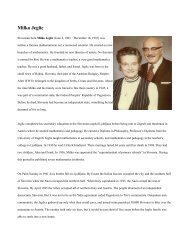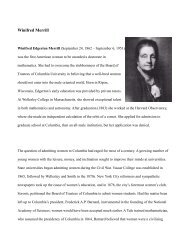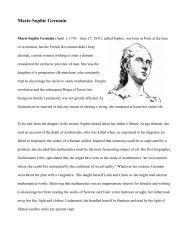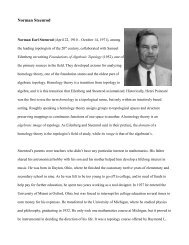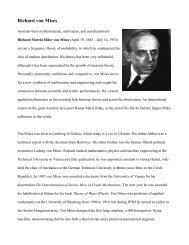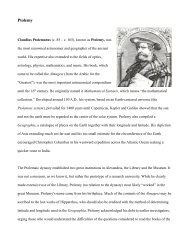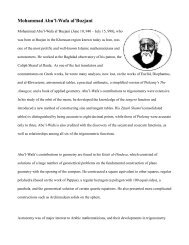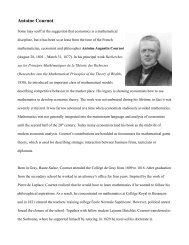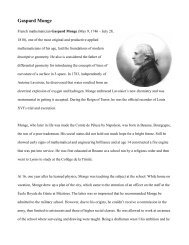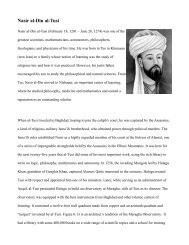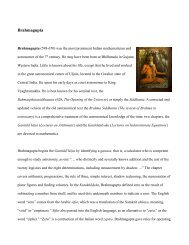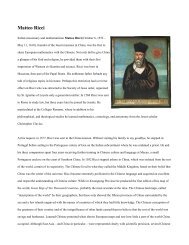DANIEL BERNOULLI
DANIEL BERNOULLI
DANIEL BERNOULLI
You also want an ePaper? Increase the reach of your titles
YUMPU automatically turns print PDFs into web optimized ePapers that Google loves.
<strong>DANIEL</strong> <strong>BERNOULLI</strong>The Bernoulli family of Switzerland played a leading part in the development of the calculus and itsapplications in the seventeenth and eighteenth centuries. Founded by Nicolaus Bernoulli, a shrewdmerchant, this dynasty produced in three generations, eight mathematicians, who in turn producedprogeny who achieved eminence in law, scholarship, science and literature.Most of the mathematicians worked mainly in applied mathematics andanalysis, and among their greatest talents was the ability to stir up anunfortunate rivalry and vigorous quarrels with each other. Today’s subject isfar the ablest of the younger Bernoullis, Daniel Bernoulli (February 8,1700 – March 17, 1782), the second son of Johann Bernoulli, and nephew of Jacob Bernoulli.Daniel Bernoulli, who became a pioneer in hydrodynamics and the kinetic theory of gases, was born inGroningen, where his father held the chair of mathematics at the University. At the age of 13 he wassent to Basel to study philosophy and logic. Having learned nothing from his resistance to his ownfather’s desire to have him enter the business profession, Johann was intent on mapping out Daniel’slife. Johann pushed his son in the direction of becoming a merchant by trying to place Daniel in anapprenticeship. Daniel resisted and Johann eventually relented. He would not have to become amerchant, but he wasn’t allowed to pursue the study of mathematics, because there was no money inmathematics. So Daniel was sent back to Basel to study medicine. Finally it became clear to Johannthat his son not only had a passionate interest in mathematics but he also seemed to have inherited thefamily’s talent for it; so he began to tutor Daniel in the methods of calculus and his theories of kineticenergy. In 1720, Daniel completed his doctorate in medicine, writing a dissertation in which he appliedmathematical physics to the mechanics of breathing.
By 1723, Daniel was in Padua, Italy. To pass the time while recovering from an illness, he invented aship’s hourglass that accurately measured one hour’s time with a flow of sand. The hourglass workedeven if it was not perfectly level, as it would be during storms. In 1725, Catherine I appointed Danieland his brother Nicolaus to positions with the Imperial Academy of St. Petersburg. Nicolaus died oftuberculosis the next year. While in Russia, Daniel investigated a problem now known as the “St.Petersburg Paradox.” The St. Petersburg game is played by flipping a fair coin until it shows a head forthe first time. If the first occurrence of a head is on the first toss, the player wins $2, if on the secondtoss, $4, on the third, $8, and so on, the payoff doubling each time. The question is how much should aplayer be willing to risk playing the game? It turns out that the expected value of the game is infinite.Later investigators of the paradox have concluded that since the expected value of the game is infinity,then for it to be a fair game the price of playing should be infinite.Finding Russia primitive, Daniel considered returning to Switzerland, but stayed when his fathersuggested that one of his own students, Leonhard Euler, would make a worthy assistant in his research.The two discovered the relationship between the speed at which blood flows and its pressure. Bernoulliexperimented by puncturing the wall of a pipe with a small open ended straw and observed that theheight to which the fluid rose in the straw was related to the fluid’s pressure in the pipe. In this way hefound the law that a moving fluid exchanges its kinetic energy for pressure. This principle, now namedfor him, is used in designing wings of airplanes in such a way as to create a fast flowing air currentabove its surface. The pressure of this area of the plane’s surface is lower and so the wing is suckedupwards. Bernoulli’s principle also has been used to explain how a baseball curves when thrown withspin. It curves because one side of the ball experiences a reduced pressure. The seams and roughness ofthe baseball are important. If the ball were perfectly smooth, there would not be enough interactionwith the air to make it curve.
In the meantime, Johann received much acclaim for his mathematical and scientific work.Unfortunately, unbeknownst to Daniel, both father and son submitted an entry for the Grand Prize ofthe Paris Academy for 1734. They were declared joint winners, which did not sit well with Johann.When Daniel returned to Basel in 1734, Johann was not ready to admit that his son was at least hisequal, and so banned him from his house. It took Daniel three years to complete his work on fluids,Hydrodynamica. Apparently in an attempt to mend the rift between himself and his father, he hadinscribed on the book’s frontispiece “by Daniel Bernoulli, Son of Johann.” The ploy didn’t work and ayear later Johann published his own work called Hydraulics, which seemed a blatant plagiarism of hisson’s work.After that Daniel Bernoulli lost interest in pure mathematics and, in 1750, he was appointed to the chairof physics at Basel, where he taught for 26 years. He won the Grand Prix of the Paris Academy ofSciences on 10 occasions, for topics ranging from astronomy to nautical matters. He wrote a number ofpapers on various mechanical questions, including problems connected with vibrating strings. Heshowed that the movements of strings of musical instruments consist of an infinite number of harmonicvibrations. Bernoulli died in Basel at the age of 82.Quotation of the Day: “… it would be better for the true physics if there were no mathematicianson earth.” – Daniel Bernoulli (perhaps showing his frustration with his mathematician father, Johann)


